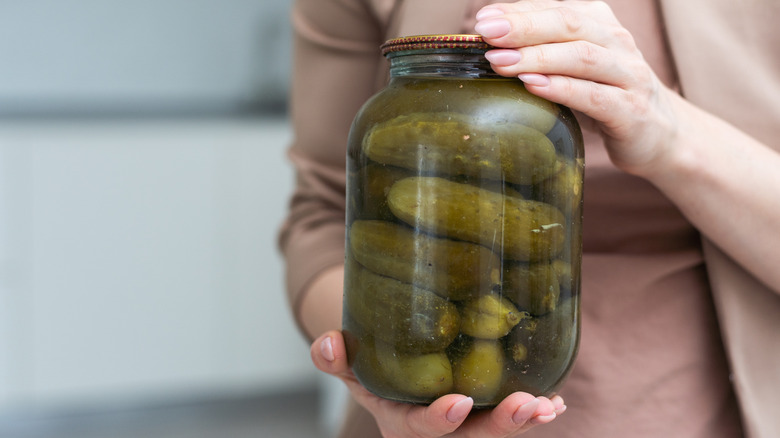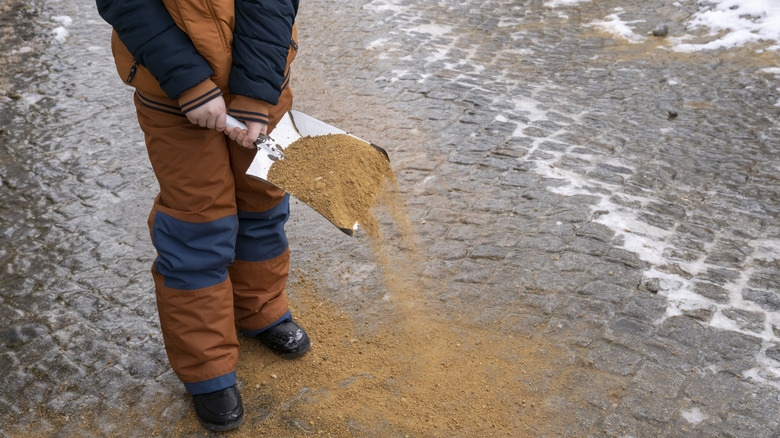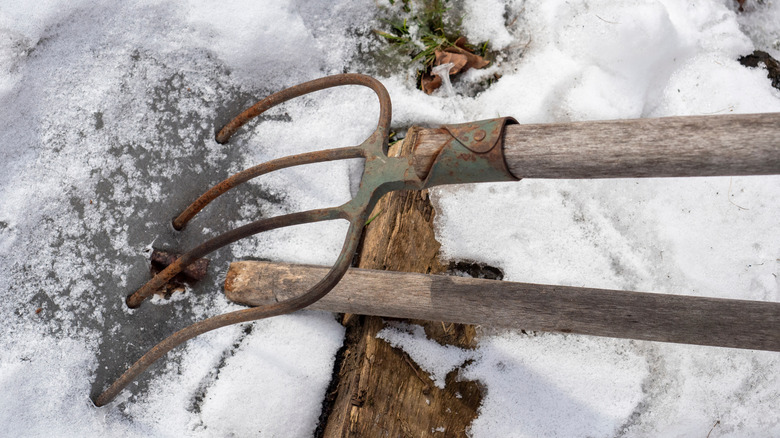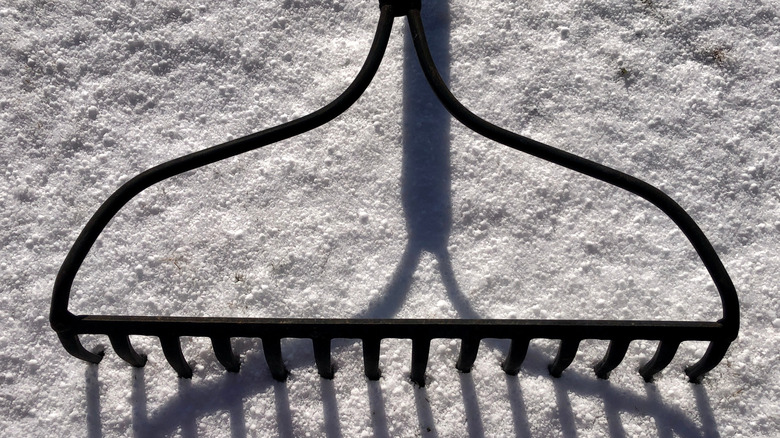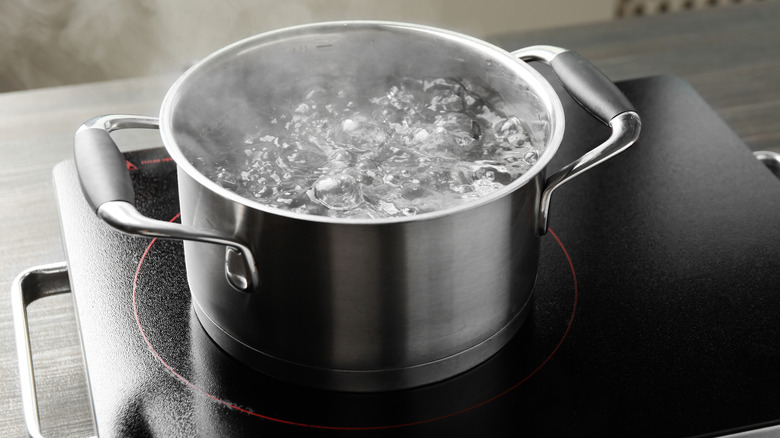10 Tools To Help Remove Ice When You Don't Have Salt On Hand
Who doesn't relish living in a winter wonderland? When the first winter chill arrives, it's lovely to sit inside and watch that pristine snowscape unfold, as snow and ice blanket our yards and gardens. Of course, just as we're starting to enjoy the enchanting view, reality hits, and it's time to trek outdoors and get knee-deep in one of the most cumbersome winter chores for homeowners: snow and ice removal. One of the most common tools for this task is salt, which removes ice by lowering the freezing point of water, causing it to melt.
However, if Jack Frost catches you off-guard and your home is out of road salt — or if you're simply in the market for some handy alternatives — there are plenty of other convenient tools you can turn to. While it's hard to beat the ice-melting might of rock salt, other materials, such as sand, which provides traction even in sub-freezing temperatures, and rubbing alcohol, which can be used on more delicate surfaces such as windows and windshields, can be a next-best choice and are easy to get your hands on in a pinch. In fact, some ice-fighting items, such as white vinegar, are probably already in your kitchen cupboard. Here are 10 things to try when your salt supply runs dry.
White vinegar
The wonders of white vinegar never cease. Not only does it make an incredibly versatile cleaning tool, but if salt is in short supply, white vinegar can also be used as a rock salt alternative during frozen winters. That's because the acetic acid in vinegar has a lower melting point than water, meaning it can help thaw ice. Simply dilute some distilled white vinegar with hot water, then use a shovel to break up the slush and discard it. However, this approach should only be resorted to in a pinch; it's likely not super effective over large areas, and not nearly as capable as commercial products at removing ice.
Pickle brine or pickle juice
Too much snow putting you in a pickle? Try using a salty ingredient: pickle juice. In fact, the state of New Jersey has resorted to this quirky method in the past when it couldn't get its hands on enough salt to keep the state's roads ice-free. You can also put it on your home's steps and walkways as a preventative measure before winter storms arrive to keep ice from getting out of control. However, the calcium chloride in pickle brine can be corrosive to metals, and this can prove to be a smelly and costly solution.
Sand
To avoid slipping and sliding on that glossy, frosty surface, we work hard to treat ice on our sidewalks and driveways. If you're wondering whether salt or sand is best for melting ice, know that sand helps you get a grip (literally) by adding traction, and, unlike salt, it works even in extremely cold temperatures. That said, the sand won't actually melt the ice, so it doesn't deal with the root of the problem. Instead, a combination of salt and sand can offer the best of both methods. If you're experimenting with this tactic, use damp sand to keep it from blowing away.
Garden pitchfork
Grab your torch and pitchforks! No, not because we're revolting against winter chores (though the idea is certainly tempting). But it does turn out that the garden pitchfork lying idly in your shed is actually the perfect tool to take to battle against stubborn ice, because while shovels are effective at removing ice and snow, they're not as good at penetrating larger chunks. So instead, simply use the pointy ends on a garden pitchfork to spear through stubborn ice and break it up before shoveling it away. (And leave the torch at home.)
Baking soda
Baking soda is an excellent alternative to road salt since it also contains sodium, meaning it can also lower the temperature of freezing ice and help it melt; it's gentler on your concrete than rock salt, which can be very abrasive; and it's probably something you already have stashed away in your kitchen cabinet. True, it won't melt the ice quite as fast or efficiently as straight-up salt. But it's certainly a convenient, easy, and safe option if you find yourself without the heavy-duty stuff.
Garden rake
When the snowy season arrives, don't put the garden rake away just yet. This tool can come in handy during wintertime as well. For a clever rake trick that makes removing snow and ice from your gravel driveway a breeze, simply hold the rake upside down with the teeth facing upwards, then push forward so that the snow piles on top of the rake. Just keep in mind that this method is more effective for dense snow and very thin, loose bits of ice — not so much for thick ice layers.
Alcohol
Clear alcohol, such as vodka, gin, or rubbing alcohol, is very effective at removing ice from fragile spots that you wouldn't want to tackle with anything abrasive. For example, alcohol is a great hack to unfreeze your home's windows in the wintertime. Simply use a spray bottle to generously apply a mixture of alcohol and water, let it sit for a minute or two, then, once the ice has started to melt, wipe with a dry cloth. Bonus: if you use vodka or gin, you can reward yourself with a cocktail when you're finished with your de-frosting chores!
Warm or boiling water
Boiling hot water can be a great way to remove extremely stubborn ice that just won't budge. Pour the boiling water over large ice chunks, then loosen and remove the melting ice with a shovel. Just be careful with this method, as pouring too much water over areas without proper drainage can create an even bigger, slipperier ice problem. And don't use boiling water on icy areas such as windshields or tires, because the quick temperature fluctuation can cause cracks and damage. Instead, try using lukewarm water on these more delicate surfaces.
Fireplace ash
When winter arrives and icy, snowy weather sets in, there's nothing cozier and more comforting than snuggling indoors by the fireplace. But did you know that the ashes from that fireplace can help melt the snow in your yard and on your driveway? Wood ash contains potassium salts that can help ice melt, and the darker color absorbs more heat from the sun, causing snow to melt more quickly. Plus, it provides some extra traction. Just be sure to allow the ashes to dry for at least 24 hours so they don't pose a fire hazard.
Calcium magnesium acetate (CMA)
Okay, so you probably don't have calcium magnesium acetate (CMA) just lying around at home to use when there's no salt available. However, if you do already have CMA on hand, it's likely because you know that this chemical compound works wonderfully as a deicing alternative to salt. Not only is it effective in freezing temperatures like traditional salt deicers, but it also requires fewer applications, is biodegradable, and, when absorbed, it actually benefits your yard's soil rather than harming it. Just be aware that it may take a little longer to work and tends to be more expensive than rock salt.


